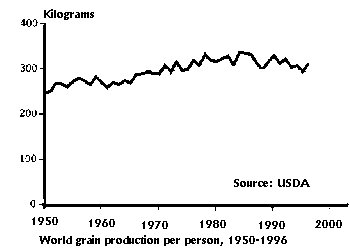
The Green Revolution and Beyond
I. Introduction
Green revolution:
Problems:
-increases in agricultural productivity have not kept pace with population growth
-What were the specifics of the green revolution?
-What are the limitations of the green revolution strategy?
-How will food production be increased in the future?
II. The Green Revolution
A. History of Plant Selection
-origins of agriculture artificial selection
-Mendelian inheritance (Lysenko & inheritance of acquired characteristics)
B. Development of High Yield Varieties
-Dr. Norman Borlaug Nobel Peace Prize 1970
-Father of Green Revolution
-developed dwarf strains of wheat (CIMMYT)
-production mexico, india, pakistan
-IITA
-IRRI
-Rice Research Center Stuttgart
C. Disease Resistant varieties
-crop improvement not just about yields
-1000's of diseases (insects, bacteria, viruses, fungi)
-50% of food crops destroyed in field or in storage
breeding disease resistant crops never ends
D. Problems With Green Revolution
high yielding/disease resistant crops are highly dependent on having optimum growing conditions (fertilizer, water, mechanization)
1. mechanized farming not available to all
2. fertilizers are expensive (N, P, K)
3. pesticides (insecticides, herbicides, fungicides) have environmental risks
4. water supply is not unlimited
5. Relationship of food supply and population growth
-Population and Food Production Trends
(data from USDA)


What is the earth's carrying capacity?
E. Possible Solutions.
How can the food supply be increased?
1. reduced tillage or no-till agriculture
2. -biological control of pests
3. organic fertilizers
4. dryland farming
exploitation of halophytes (salt water crops)
5. maintain genetic diversity of crop plants
risks of monoculture lessons of potato famine
National Seed Storage Laboratory
National Plant Germplasm System
6. genetic improvement of crop plants through biotechnology
7. maintain habitat for wild relatives of crop plants/ Botanical Reserves & Gardens